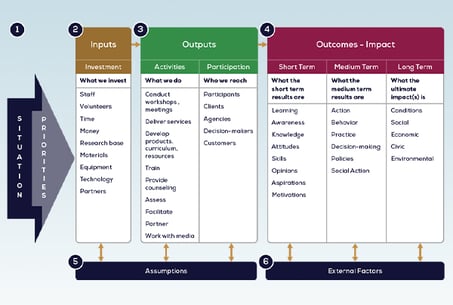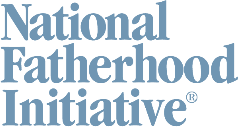
Can you articulate how your organization influences dads to improve their fathering skills?
If not, then a logic model is what you need.
A logic model maps the specific resources and activities necessary to produce the desired changes in the dads you serve, their families, and your community. It is not only a helpful tool to guide your decisions but also a great way to describe and justify your fatherhood work to staff, board members, and funders.
Now that you know a logic model is helpful for your fatherhood work, how do you create one? (Don’t worry, it’s not as daunting as you might think.)
A logic model shows what you want dads to gain from your program. It includes what is needed to reach program goals. Here are some basic parts of a simple and useful logic model:
- Inputs are resources that go into your fatherhood program or initiative. They are what you will invest in. Inputs include time, staff, money, materials, equipment, research, partners, networks, and supplies.
- Outputs are the activities that you do and provide to your dads as products and services. Your outputs can include activities like workshops, counseling, volunteer development, training, fatherhood materials, health screening, and media campaigns.
- Outcomes or Impacts are the changes you want to see as a result of the activities. Outcomes can happen at the individual and community (or system) levels. You can measure outcomes as changes in attitudes, behaviors, knowledge, status, and skills for individuals. You can measure those same changes in the community around responsible fatherhood. You might want outcomes not only for dads but for moms’ and dads’ children affected by responsible fathering. At the community level, think about outcomes in certain sectors (e.g., schools doing more to reach dads). Outcomes can be short-term (e.g., within a few months), medium-term (within a year), or long-term (two to five years or longer) and depend on the time it will take to see results. Most organizations find it easier to measure short and medium-term outcomes. Most short-term outcomes reflect changes in your audience’s awareness, attitudes, knowledge, and motivation. Medium-term outcomes are more substantial changes in your dads’ behavior. Long-term outcomes involve sustained or maintained changes among dads, and that’s where most community-level changes reside.
Here is a great visual example of a logic model.
So, what’s the best way to apply this knowledge?
I recommend putting a team together (e.g., staff, board members, and volunteers) to brainstorm what to include in each part of the logic model.
If you already have a fatherhood program or initiative, then enter your current inputs, outputs, and outcomes, then assess whether you are missing anything or need to rethink any elements.
If you don’t currently have a fatherhood program or initiative, then consider the outcomes you want to see as a result and plug in the inputs and outputs your team thinks would create the best chance of success. For example, you may have to designate a staff person to oversee your work with dads, select a fatherhood curriculum, or design an evaluation process.
Here are a few examples of resources and technical assistance from National Fatherhood Initiative® (NFI) that can supercharge your logic model:
- For your “inputs” section, consider having NFI conduct a Father Engagement Experience™ for your logic model team. It is an invigorating, interactive, in-person strategic planning session to guide your logic model creation.
- For your “outputs” section, consider implementing the 24/7 Dad® program. This evidence-based program is used by hundreds of organizations to improve the knowledge, behaviors, and skills of dads of all kinds. It also includes the Fathering Survey – a pre- and post-assessment tool that can be used in your “outcomes” section.
- Fatherhood brochures, tip cards, and pocket guides are easy-to-distribute resources that raise awareness of dads’ irreplaceable role and can be used by staff as discussion starters with dads and moms.
A logic model is a fantastic tool that can help turn your organization’s vision into reality. It will ensure you have a process to plan, carry out, and measure the success of your team’s efforts. When the well-being of children and families is at stake, it is well worth the investment.
If you currently have a logic model for your fatherhood work, is it time to revisit the inputs, outputs, and outcomes to explore updates and improvements?
If you don’t currently have a logic model for your fatherhood work, determine who should be on your team to create one and schedule the first planning meeting.










